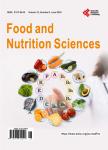Antioxidant Potential of Extracts from Processing Residues from Brazilian Food Industries
Antioxidant Potential of Extracts from Processing Residues from Brazilian Food Industries作者机构:EQA-CTC/UFSC Chemical and Food Engineering Department Federal University of Santa Catarina Florianópolis Brazil
出 版 物:《Food and Nutrition Sciences》 (食品与营养科学(英文))
年 卷 期:2013年第4卷第8期
页 面:211-218页
学科分类:1002[医学-临床医学] 100214[医学-肿瘤学] 10[医学]
主 题:Supercritical Fluid Extraction Shrimp Residue Grape Pomace
摘 要:The objective of this work was to estimate the antioxidant potential of the extracts from pink shrimp residue and red grape pomaces (Merlot and Syrah varietals), evaluated according to its antioxidant activity with different analytical methods, associating these properties with the chemical composition of the extract and, as a consequence, with the extraction procedure. The shrimp residue was pre-treated combining cooking, drying, and milling, whereas the grape pomaces were dried and ground. The shrimp residue extracts were obtained by Soxhlet (SOX) and by maceration using hexane (Hx), hexane: isopropanol (50:50) (Hx:IPA), isopropanol, ethanol (EtOH) and acetone as solvents;by ultrasonic maceration (UME) with EtOH;by cold and hot oil extraction with soy and sunflower oils;and by Supercritical Fluid Extraction (SFE) with pure CO2 (100 -?300 bar;313.15 -?333.15 K) and with co-solvent (Hx: IPA and sunflower oil at 2%). The grape pomaces extracts were obtained by SOX using EtOH, ethyl acetate (EtOAc) and Hx;UME with water (H2O), EtOH, EtOAc and Hx;and by SFE performed with pure CO2 (150 -?300 bar;323.15 -?333.15 K) and with cosolvent (EtOH at 15%). The antioxidant activity was determined by the DPPH free radical scavenging procedure and by the β-carotene bleaching method. Higher antioxidant activities in shrimp residue extracts were observed by the β-carotene bleaching method in alcoholic and cetonic extracts, among the low pressure extraction methods, while for the SFE, the higher activities were achieved by the extracts obtained at elevated pressures. For the grape pomaces extracts, the best results were obtained by the DPPH method from the low pressure extractions proceeded with EtOH. The SFE with Merlot pomace at 323.15 K/150 bar (the lowest temperature and pressures tested) presented the best antioxidant activity by the β-carotene bleaching.



